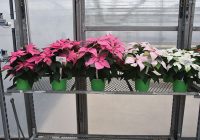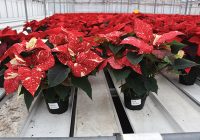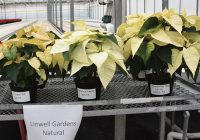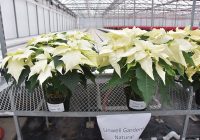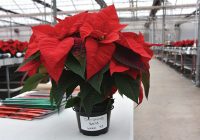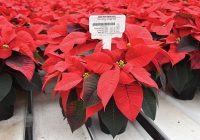
Features
Biocontrols
Crop Culture
Flowers
New Varieties
New Varieties
PGRs
Lessons from the 2020 poinsettia season
Small changes could reduce risks and improve profit margins.
February 16, 2021 By Melhem Sawaya
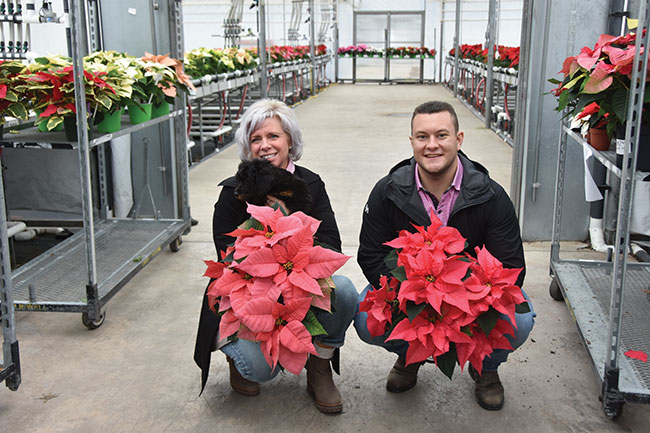 Tanya Carvalho of Selecta North America holds up Christmas Wish Pink, while Maximillian Epp of Dummen Orange has Early Polly’s Pink.
Tanya Carvalho of Selecta North America holds up Christmas Wish Pink, while Maximillian Epp of Dummen Orange has Early Polly’s Pink. “If all the factors that took place last year are repeated in the next, and all the suggestions in this article are taken, then growing poinsettia could be profitable.” This was the final sentence of last year’s poinsettia recap article for the 2019 season.
In 2020, all of the factors were repeated, with a few additional improvements. But still, it seems there were some systemic traditions that we did not yet have the courage to change.
Ontario’s poinsettia season ended well this past year, even though almost 60 to 70 per cent of the charity fundraisers and church sales did not happen due to COVID-19. On the other hand, there was at least a five per cent reduction in poinsettia production due to some growers who stopped producing the crop entirely and others who reduced their production volumes. If production numbers from 2019 had stayed the same in 2020, we could have avoided slight shortages in some sizes.
The reason why some growers stopped growing poinsettia was the small profit margin relative to the risks of growing the crop, which makes it a very questionable crop. This is not a new realization, but to my knowledge, it has been this way for the past 43 years. So, why is one of the largest known flowering potted crops grown grudgingly?
The answer always comes back to low profit margins compared to risks taken.
In the 80s and 90s, we used to think that growing more per square foot would be the solution to the problem because heating costs would then take up the highest percentage of the total cost. We countered that by growing plants suspended in the air as well as smaller sized plants, but that led to overproduction and a drop in selling price. Desperate for ways to get rid of a crop we had invested in, it became a buyer’s market that took advantage of the oversupply.
Correction to the oversupply began in the 2000s when production was cut by at least 20 per cent. Production started to become somewhat in line with demand. In the years that followed, the mantra, “grow to only what is ordered” took hold.
In the meantime, labour costs started climbing drastically, and mechanization began to be taken more seriously. It was not just potting machines and rollers, but the entire greenhouse infrastructure, such as taking out benches and installing flood floors so machinery could handle moving product and robots could take the night shift and space pots. All these changes came with a cost that required a higher profit margin to survive, and they worked, only to be eaten up by rising shipping costs.
For the last 10 to 15 years, poinsettias have been sold on prices previously agreed upon with hardly any price cuts. But that price was not negotiated. Rather, it’s been forced on by the big buyers, with no understanding of how the product can be improved in quality and presentation and still be economical for the consumer, the buyer, and the grower.
Production technology is always progressing, but adopting it takes a little more time for some growers because of the mentality “if it’s not broken, don’t fix it.” This thinking only works until the whole process of growing the plants becomes so backwards that there is no way to compete at the level of the other growers who have been improving little by little all along. This goes for all other crops, too.
With that in mind, try to be open to new ideas. Small changes in production practices could reduce the risks and improve the profit margins on poinsettias. Here is a recap of the 2020 season, along with some suggestions to help improve your bottom line for 2021.
Production
If I thought last year’s weather conditions were optimal for flower initiation and bract colouring, this year’s were even better. With slightly cooler nights and bright sunshine for 10 to 12 days towards the end of October, it was a perfect environment for producing a perfect crop.
Micro drenches of Bonzi can be used at any stage of production. It will not reduce the bracts to unsalable conditions. Proper applications of Bonzi will produce a much better-quality product.
Here some guidelines to consider when you are using Bonzi:
- PGR applications should be uniform, especially if you are using a drip system, in which case, use lower rates with high volumes so the whole root ball is evenly wet. This is also important for non-PGR irrigation with drip systems.
- Treatments are more effective when the plants are in the fast-growing stage. This goes for using any growth regulator. You should track the height of the plants right after pinching.
- Avoid any Bonzi applications overhead, but if that is the only way you can apply it, then rinse with clear water using your sprayer and not the watering nozzles.
- Timing is the best growth regulator. Having said that, you cannot delay planting to have shorter plants because the bracts will not colour properly in low light conditions.
- If a later crop sale date is required, grow a later flowering variety in its own section. That way, you can control the temperature without affecting other cultivars. Some crops shipped later in the season, but were not programmed for it, showed signs of Botrytis on the bracts as well as cyathia drop.
If you are spraying Cycocel, be aware of your clear water EC. Cycocel normally has a high EC. When mixed with high EC water, this leads to phytotoxicity for the plants, and not just for poinsettias.
Overall, the best forms of Botrytis control are still lower humidity without drastic fluctuations in temperature.
The best crops are grown when all aspects of production are completed on time. Yes, I am saying it again and it will not be the last time: When growing crops, 15 per cent is knowledge, 15 per cent is knowing how to apply this knowledge and 70 per cent is completing everything on time.
Timing is a major part of growing green because fewer or no chemicals treatments are needed that way.
Varieties
There are many new promising poinsettia varieties these days.
At the open house at Cherry Creek Greenhouses this year, we saw remarkable varieties of interest that were improvements over the older genetics. You can choose among them to fit a certain pot size or shipping date.
Varieties suitable for one size may not necessarily be good for other sizes without changing the timing and culture. This also goes for shipping dates.
There are varieties that flower by November 10 without any blackout. They can be grown in any size by adjusting the scheduling. The time between pinching and short days determines the desired final size. Short varieties or vigorous varieties can be manipulated to be grown into any size, as long as you know the time of the year for flower initiation and adjust accordingly with sticking and pinch dates. The longer the length of time between pinching and short days, the taller the finished size, as long as all other factors are the same.
In Canada or any region north of the 42nd parallel, we can only grow varieties that initiate flowers by Sept. 30 in order to produce vibrant bracts. That is, unless the crop is finished under high intensity lights during the day. Poinsettia bracts or any other flowering bracts need specific temperatures and light intensities to colour properly.
The cuttings for the trials this year arrived in much less than optimal condition. Due to timing and shipping logistics, the cuttings took much longer than normal to root, which delayed production schedules. To compensate, the crop was lit until Sept. 29 for extra vegetative time. This meant no growth regulators applied. The result was less than optimal, but it was still an excellent trial where we could clearly see the differences between a doctored crop and a normal crop with proper timing.
Here were some of the promising varieties:
– Red: Christmas Bells, Mirage, Imperial, and Ferrara Red. These varieties have V-shaped habits that eliminate the need for rings and have excellent breaks, good centres and strong branches.
– White: Alaska, Frozen, Biancaneve, J’Adore White Pearl, and Princettia Pure White. These pure white varieties have different growing habits but are excellent once growers become familiar with them.
– Off-white: Candy Wintergreen, Christmas Beauty North Pole, Wintersun White.
– Pink: Early Polly’s Pink, Christmas Joy Pink, Carina Hot Pink.
– Novelty: Superba New Glitter, J’Adore series, Princettia series.
Red poinsettias account for at least 93 percent of the total poinsettias grown, with four per cent white, two per cent pink and one per cent miscellaneous
Remember, new varieties are only for you to try. If you like how they grow and they meet consumer tastes, then increase production and get rid of the varieties that they can replace.
Regardless of which variety you grow, ensure that the planting media is not flush with the pot rim. This gives stores and homeowners a reservoir to be able to water the plants more effectively.
Diseases
Almost all growers experienced zero issues with any kind of disease, except for a small number of Erwinea incidents that were directly related to plant stress from delays in shipping.
There were no issues with root problems and no preventative fungicides were applied. Diseases generally do not want anything to do with happy plants, and happy plants do not welcome diseases.
Proper watering, checking for EC’s and pH’s along with proper environmental conditions, set the stage for plant health with no need for fungicides.
Insects
Whitefly was not an issue this year for the following reasons:
- Stock producers are doing a much better job at shipping cleaner cuttings.
- Almost all cuttings are receiving a dip treatment, which takes care of any hidden whitefly adults or eggs.
- The dip can neutralize residual chemicals applied by the stock producers, so the bios work more effectively.
- Almost 98 per cent of the growers are dipping the cuttings again before planting, because the dip is more effective on hatched eggs that could be carried on the cuttings.
- The same 98 per cent of growers used bios as their first line of defense
- There was no need for a second line of defense, though some growers applied certain chemicals as insurance.
At the end of the season, here was the consensus on how to control whitefly in poinsettia.
- Before propagation and planting, the planting areas are to be cleaned thoroughly with no pet plants or other crops around.
- Open the boxes in a cool room and dip cuttings in the Botanigard solution. Put them in a cool room at 10 degrees Celsius overnight, or at least 4 hours before sticking, making sure the cuttings are never dehydrated.
- Before sticking, dip cuttings in an insecticidal soap.
- Before planting, dip the cuttings in a mixture of Botanigard and horticultural soap.
- Start bio treatment soon after, until around Oct. 10 to 15.
- Shift to chemicals if needed at finish.
All this is essential to achieving a profitable crop, but there are new issues around extra costs including labour, shipping, price of cuttings (which have doubled compared to 10 years ago), bio treatments to achieve green production, and greenhouse expansions now cost at least 30 per cent more compared to what they were only three years ago.
If these costs are not reflected in the selling price, then we are on a slippery slope that could severely reduce the number of growers producing poinsettia.
Key takeaways
Here were some of the key takeaways from this past season.
- Grow varieties that you are familiar with and try new ones on a small scale.
- Calculate your costs for any required specs and do not forget about packaging and shipping.
- Take an order when there is still some profit margin and not just dollar sales.
- Never grow on pure speculation.
- If you run out of plants at the end of the season and you need to buy more, that is when you are starting to make headway profit-wise.
- Do not cheat on what the crop needs to grow properly. It will cost you much more at the end if you do.
- Discuss your actual costs with your buyer and all the increases you are facing, especially if they want you to be able to continue supplying them with quality product.
- Start a study group with the growers in your vicinity. If you are around southwestern Ontario, join us by sending me an email. That was impossible due to COVID-19 last year. Hopefully, this year will be different.
And finally, if all the factors that took place this year are repeated again next year, then growing poinsettia could be profitable.
Next year, the poinsettia trials will take place at the newly relocated Sawaya Gardens. We will look at different ideas on how to present a better-quality product at an economical cost. At the same time, we will work with some buyers and breeders to better reflect their requirements. This way, all facets of the industry, as well as the consumer, can be successful.
Melhem Sawaya of Focus Greenhouse Management is a consultant and research coordinator to the horticultural industry. He can be reached at mel@focusgreenhousemanagement.com.
Print this page
